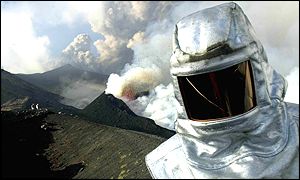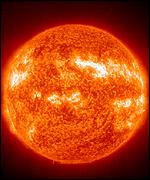Week's Assigned Readings
Slides to Class 2 Lectures - Part 1 & Part 2
Supplementary Material for Week 1
Class Research Resources and Assignments
Week 2
Basic
Concepts of Ecology
Week's Assigned Readings
Videos
of Week 2 Lectures
Slides to Class 2 Lectures - Part
1 & Part
2
Supplementary Material for Week 1
|
| Read and consider the following recent news items.
|
| Etna's
rising anger |
 |
| Supervolcanoes
could trigger global freeze Thursday, 3 February, 2000, 10:34 GMT The threat of climate change caused by human activity could turn out to be a minor problem by comparison with a scarcely acknowledged natural hazard. Geologists say there is a real risk that sooner or later a supervolcano will erupt with devastating force, sending temperatures plunging on a hemispheric or even global scale. A report by the BBC Two programme Horizon on one supervolcano, at Yellowstone national park in the US, says it is overdue for an eruption. |
| Giant
sunspot erupts Friday, 30 March, 2001, 14:04 GMT 15:04 UK explains how we might be affected By BBC News Online science editor Dr David Whitehouse Two major flares have erupted on the surface of the Sun in the region of the giant sunspot group designated Noaa 9393. The group is the biggest seen on the surface of our star for more than a decade. One of the flares (explosions in the Sun's atmosphere) was so energetic that it ejected a cloud of superhot gas into space. Solar observers say that the cloud, called a coronal mass ejection (CME), is heading towards the Earth and will reach us within the next 24 to 36 hours. Scientists are predicting a "geomagnetic storm" when it reaches us. There may be radio and communications interference, and possibly a fine display of the Northern, and Southern, Lights, visible from lower latitudes than is usually possible. |
 |
| Mystery
space blast 'solved' Tuesday, 30 October, 2001, 18:13 GMT By BBC News Online science editor Dr David Whitehouse Astronomers may have solved the puzzle of what it was that brought so much devastation to a remote region of Siberia almost a century ago. In the early morning of 30 June, 1908, witnesses told of a gigantic explosion and blinding flash. Thousands of square kilometres of trees were burned and flattened. Scientists have always suspected that an incoming comet or asteroid lay behind the event - but no impact crater was ever discovered and no expedition to the area has ever found any large fragments of an extraterrestrial object. |
|
In the
past month, meteor fever has reached new heights. |
| In terms of the cosmic encounters discussed in class we on Earth have experienced some recent "close calls" -- although virtually all of us remained blissfully ignorant of these events. Consider, for example, the following news items related to the broadcast compiled by Dan Damon above: | ||
| see: | Monday,
9 September, 2002, 12:19 GMT 13:19 UK But according to US Brig Gen Simon Worden, if it had occurred at the same latitude a few hours earlier, the result could have been much worse. Had the explosion occurred over India or Pakistan, the resulting panic could have sparked a nuclear war, Worden says. |
|
| and | Wednesday,
24 July, 2002, 04:38 GMT 05:38 UK Astronomers say they've
discovered a large object in space which poses the greatest risk of colliding
with the Earth, ever detected. |
|
| and | Thursday,
20 June, 2002, 16:29 GMT 17:29 UK What has worried some astronomers, though, is that the space object was only detected on 17 June, several days after its flyby. |
|
| In addition, evidence is accumulating about more ancient and remote encounters: | ||
| Friday,
23 August, 2002, 09:01 GMT 10:01 UK |
||
| Closer to home other real threats exist to our familiar forms of civilization: | ||
| Giant
wave devastation feared An immense wave could one day wreak havoc on the eastern seaboard of the US and elsewhere around the Atlantic. Scientists say a volcanic eruption on the Canary Islands, off West Africa, could trigger a vast undersea landslide. This would set off a tsunami wave capable of inundating coastal regions thousands of kilometres away. |
||
Supplementary Material
|
|||||||||||||||||||||||||||||||||||||||||||||